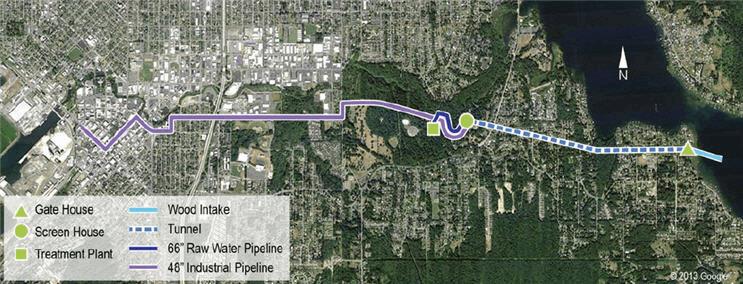Lessons On Rightsizing Water And Sewer Infrastructure Projects
By Daniel Buonadonna and Tammy Cleys
Two case studies prove that the key to cost-effective condition assessment is choosing the right approach for your system.
Aging infrastructure and infrastructure spending are two hot topics in the news today. Given that much of the United States’ infrastructure is aging and reaching the end of its useful life, many municipalities and water/wastewater utilities recognize the cash infusion needed to update, repair, or replace their water infrastructure. In the U.S. alone, an estimated 240,000 water main breaks occur every year; addressing this issue is estimated to cost in the hundreds of billions. Wastewater and stormwater systems need attention, too, with an estimated cost of nearly $200 billion over the next 20 years.
For centuries, centralized largediameter wastewater interceptors and large-diameter drinking water transmission lines have frequently been the backbone of a municipal system. Today, we are seeing many large-diameter pipelines that have been in service well past their design life fail, which is why sinkholes, pipe collapses, and overflows are making the local headlines frequently. The consequences of pipe failures to the communities, including fines cities must pay, are significant.
Portland Trailblazing
To prevent these types of problems from occurring in wastewater collection systems, many cities and utilities are taking proactive steps. By implementing asset management programs to assess the condition of their large-diameter pipelines, they are addressing problem areas before they become worse. The City of Portland, OR, is one utility that has established an asset management team and invested in a strategy to identify the pipes with the highest risk exposure and prioritize between urgent projects by determining which rehabilitation approach provides the greatest value.
The city put its strategy to the test on one of its aging brick sewers, the Taggart Outfall 30. Constructed in 1906, the 7,600-linearfoot (LF), 66 to 120” brick sewer was used to replace cesspools, helping reduce the death rate from typhoid fever and other infectious diseases in Portland’s densely settled neighborhoods. At the time, with an initial budget of $250,000, it was the largest diameter and most expensive sewer Portland had constructed. Over the past century, the city’s Bureau of Environmental Services has continued to utilize this asset with multiple retrofits that allow the tunnel to function today as a critical piece of the combined sewer infrastructure, rerouting wet weather flows through different diversion structures and relief sewers.
In 2014, the city engaged CH2M to perform a condition assessment to evaluate rehabilitation alternatives that could provide a long-term solution to the historic pipeline. The unique characteristics and large dimensions of the outfall allowed a broad range of trenchless technologies to be considered, including tunnel rehabilitation technologies. To address the city’s challenges and find the “right-size rehabilitation” plan, a net benefit cost ratio (NBCR) approach, which took into consideration the consequence of failure, likelihood of failure, and cost of alternatives, was used to evaluate the life cycle costs and risk mitigation for each rehabilitation strategy.
The outcomes of the NBCR calculation and evaluation method and valid alternative selection. By quantifying the likelihood of failure (in time) and reducing all the consequences of failure, as well as the potential alternatives down to triple bottom-line costs (in dollars), much of the subjectivity of other alternative analysis methods is avoided. While the Taggart Outfall 30 project team moves forward into design, the Portland Bureau of Environmental Services is continuing to refine and improve their powerful NBCR asset management tool.

City of Bellingham water supply facilities
Tiers In Bellingham
For drinking water assets, the City of Bellingham, WA, is another example of a city taking proactive steps to address its aging water system. Constructed in 1939, the city’s five-mile buried water supply system, which consists of a 66” wood stave intake pipe, a 78” hand-dug tunnel, and 48”/68” concrete cylinder supply pipelines, was constructed to take raw water from Lake Whatcom and convey it to the city’s 24-MGD Whatcom Falls Water Treatment Plant. For the eight decades it has been in use, the system has reliably served the city.
In an effort to extend the system’s useful life, the City of Bellingham engaged CH2M to perform a condition assessment of the intake system between Lake Whatcom and the treatment plant.
Undertaking this thorough condition assessment was an important component of the city’s approach to characterize its assets, identify the key repairs needed, and prioritize the repairs with the available budget and resources. A tiered approach with three levels of assessment was utilized for the condition assessment.
- Tier 1 assessment represents the first-level, least-invasive, and least-costly methods of inspection, such as nondestructive and visual testing.
- Tier 2 efforts would be warranted if issues or concerns are discovered during the Tier 1 assessment. Tier 2 activities primarily include methods such as excavation of test pits and collection of pipe materials or samples. Entry into the interior of the pipe could be considered a Tier 2 activity if access is readily available or reasonably feasible without major modification.
- Tier 3 activities, if warranted, could be considered upon completion of Tier 2 activities and evaluation of those results. Tier 3 activities involve deploying instruments within the pipe and/or removing the asset from service and conducting a manned entry examination of the interior of the asset. Tier 3 activities are typically the most costly to implement of the three tiers of assessment activities.
Applying the same approach to each of the city’s buried water assets, the tiered approach provided a cost-effective way to assess the condition of the whole intake system within the budget constraints of the city and provided meaningful data on what steps the city must take to keep its water infrastructure functioning properly. While Bellingham’s existing intake system remains useful and in relatively good condition, preserving the long-term usable condition of this system and others like it will require regular monitoring, inspection, analysis, improvements, and target replacement of key elements.
To stay ahead of the problems associated with deteriorating aging infrastructure, condition assessment and rehabilitation is a critical component of a pipeline asset management program. As these case studies demonstrate, it is equally as important to select a “right-size” condition assessment strategy to identify the most cost-effective method. Thoughtful implementation of such a program is necessary to avoid overspending on inspection and overanalyzing the system beyond what is necessary to provide our cities with a high level of service, while managing acceptable risks and minimizing costs to ratepayers.
About The Authors

Daniel Buonadonna joined CH2M in 2008 and currently serves as the Global Practice Lead for CH2M's Assessment and Rehabilitation Services (CARS) team. Daniel is dedicated to helping communities face the challenges associated with aging infrastructure and asset management.

Tammy Cleys is a supervising engineer for the City of Portland, Bureau of Environmental Services and has been the project manager for several large-diameter conveyance projects ranging from new tunnel construction to trenchless rehabilitation.
